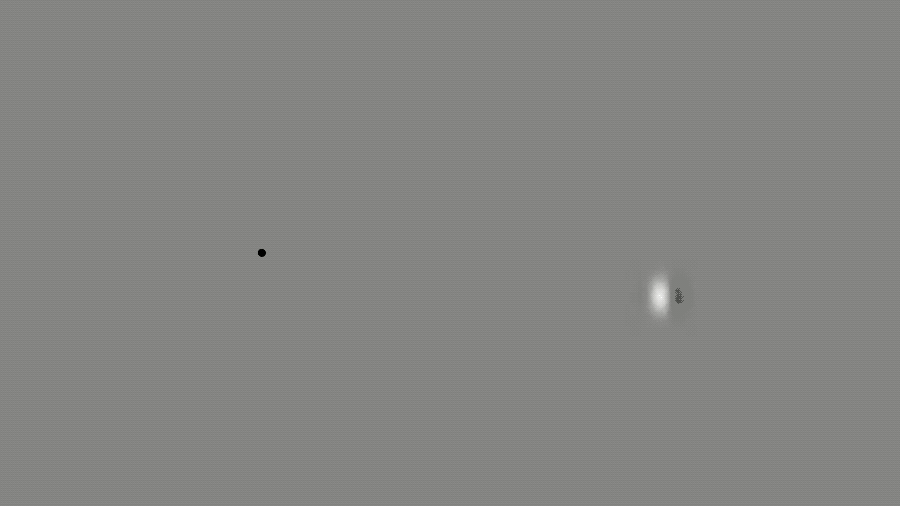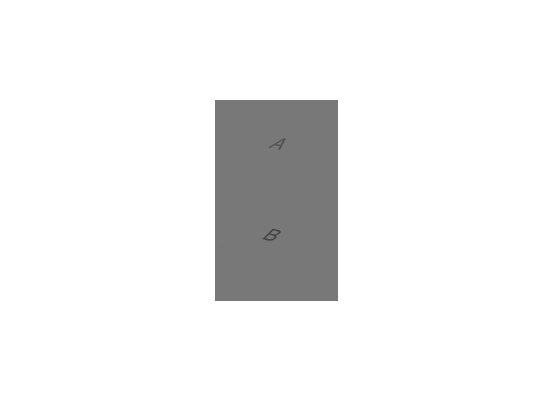Think You Cant Be Fooled Read It Again Answer
"Reality" is constructed by your brain. Here's what that means, and why information technology matters.
What the scientific discipline of visual illusions can teach united states nearly our polarized world.
Set your gaze on the black dot on the left side of this image. Only wait! Terminate reading this paragraph first. As y'all gaze at the left dot, attempt to answer this question: In what direction is the object on the right moving? Is it drifting diagonally, or is it moving upward and down?
Recollect, focus on the dot on the left.

It appears as though the object on the right is moving diagonally, upwards to the right and then back down to the left. Right? Right?! Actually, it's non. It'south moving up and down in a straight, vertical line.
See for yourself. Trace it with your finger.
This is a visual illusion. That alternating blackness-white patch inside the object suggests diagonal motion and confuses our senses. Like all misperceptions, it teaches united states that our experience of reality is not perfect. Just this particular illusion has recently reinforced scientists' agreement of deeper, almost philosophical truths about the nature of our consciousness.
"It's really of import to understand we're not seeing reality," says neuroscientist Patrick Cavanagh, a research professor at Dartmouth College and a senior fellow at Glendon College in Canada. "We're seeing a story that's existence created for us."
Near of the time, the story our brains generate matches the real, physical world — but not ever. Our brains as well unconsciously curve our perception of reality to encounter our desires or expectations. And they make full in gaps using our past experiences.
All of this can bias united states. Visual illusions nowadays clear and interesting challenges for how we live: How do we know what'due south real? And once we know the extent of our brain'southward limits, how do we alive with more humility — and think with greater intendance about our perceptions?
Rather than showing us how our brains are cleaved, illusions give us the hazard to reveal how they piece of work. And how do they work? Well, as the owner of a human brain, I have to say it's making me a piffling uneasy.
Where the disharmonize between perception and reality lies in the brain
My colleague Sigal Samuel recently explored the neuroscience of meditation. During her reporting, she establish good bear witness that a regular meditation do is associated with increased compassion. That bear witness, she writes, "experience[southward] similar a claiming, even a dare. If it takes such a small amount of time and endeavour to get better at regulating my emotions ... am I not morally obligated to practice information technology?"
Perception science, for me, provokes a similar question. If the scientific discipline tells us our brains are making up a "story" nearly reality, shouldn't we exist curious well-nigh, and even seek out the answers to, how that reality might exist wrong?
It'due south not about doubting everything that comes through our senses. It's most looking for our blind spots, with the goal of condign ameliorate thinkers. It can also assist with empathy. When other people misperceive reality, we may not hold with their interpretation, just we can understand where information technology comes from.
To approach this challenge, I retrieve information technology helps to know that the brain is telling us stories near the smallest things we perceive, similar the motion of objects. But it as well tells us stories about some of the virtually complex things we recollect nearly, creating assumptions about people based on race, amongst other social prejudices.
Permit'due south start with the minor.
In 2019, Cavanagh and his colleagues Sirui Liu, Qing Yu, and Peter Tse used the above "double migrate" illusion of the two dots to probe how our brains generate the illusory diagonal move.
To figure this out, Cavanagh and his colleagues ran a neuroimaging study that compared how a encephalon processes the illusory blitheness with how information technology processes a like, not-illusory animation. In this 2d blitheness, the object on the right actually is moving diagonally. Trace it with your finger again.

With fMRI neuroimaging, which allows researchers to map brain activity, Cavanagh and his squad could enquire the question: If we perceive each animation similarly, what in our brains makes that happen? What's the source of the illusion in the first animation? "Nosotros want to find where the conscious perception diverges from the concrete sensation," Cavanagh says.
Ane possibility is that the illusion is generated in the visual cortex. Located at the back of your head, this is the part of your encephalon that directly processes the information coming from your optics. Maybe the visual arrangement "sees" information technology wrong. The alternative is that the visual system "sees" it merely fine, but another part of the brain overrides it, creating a new reality.
The experiment included only ix participants only nerveless a lot of information on each of them. Each participant completed the experiment (and was run through the brain scan) ten times.
Hither's what the analysis found. That visual system in the back of the brain? It doesn't seem fooled by the illusion. Each animation produces a different design of activation in the visual cortex. In other words, "the visual system thinks they are different," Cavanagh says.
Okay, the visual system correctly "sees" these two animations differently. Then why practice we perceive them as being the same?
The patterns of activation in the frontal lobes of the participants' brains — the higher-level thinking expanse dedicated to anticipation and decision-making — were similar. That is: The front of the brain thinks both animations are traveling in a diagonal direction.
"There'due south a whole world of visual analysis and computation and prediction that is happening outside of the visual system, happening in the frontal lobes," Cavanagh says. That's where the "story" of reality is constructed — at least in this i example, every bit evidenced past this one small study. (To be certain: Vision is a vastly circuitous arrangement involving around 30 areas of the brain. There are other illusions that do seem to "fool" the visual cortex, because no story well-nigh the brain can be simple.)
But you don't need an fMRI to conclude that some function of your brain is overriding the plain truth about the path of the object. Yous can see information technology for yourself. "The remarkable thing is that — even when you are told what is happening — yous notwithstanding see it in the illusory form," Justin Gardner, a Stanford University neuroscientist who wasn't involved in this study, said in an electronic mail. "Y'all can't seem to consciously override the 'wrong' interpretation."

The lesson: The stories our brains tell us well-nigh reality are extremely compelling, even when they are wrong.
We're non seeing reality. Our vision runs 100 milliseconds behind the real earth.
Why are we seeing a story nigh the world — a story — and not the real deal? It's not because evolution made our minds flawed. It's actually an adaptation.
"Nosotros don't have the necessary machinery, and we wouldn't even desire it, to process carefully all of the amount of information that we're constantly bombarded with," says Susana Martinez-Conde, a neuroscientist and illusion researcher at SUNY Downstate Medical Center.
Think almost what it takes to perceive something move, like the objects in the above animations. One time low-cal hits the retinas at the back of our eyeballs, information technology'southward converted into an electrical point that then has to travel to the visual processing system at the back of our brains. From there, the signal travels frontwards through our brains, constructing what we see and creating our perception of it. This process only takes time.
"The dirty little secret about sensory systems is that they're slow, they're lagged, they're non almost what's happening correct now but what's happening 50 milliseconds agone, or, in the case for vision, hundreds of milliseconds agone," says Adam Hantman, a neuroscientist at Howard Hughes Medical Plant'south Janelia Research Campus.
If nosotros relied solely on this outdated information, though, we wouldn't exist able to hit baseballs with bats, or swat abrasive flies away from our faces. We'd exist less coordinated, and possibly get hurt more than oftentimes.
So the encephalon predicts the path of move earlier it happens. It tells us a story most where the object is heading, and this story becomes our reality. That's what's probable happening with Cavanagh'south illusion. It happens all the time.
Don't believe it? Run into for yourself. Here's a uncomplicated illusion that reveals our visual system is a fleck lagged.
It'southward chosen the flash-lag illusion. The scarlet dot is moving across the screen, and the green dot flashes exactly when the red dot and dark-green dot are in perfect vertical alignment. Yet information technology's incredibly hard to run into the ruby dot and the green dot as being vertically aligned. The reddish dot always seems a niggling bit farther ahead.

This is our brain predicting the path of its motion, telling united states of america a story most where it ought to be and not where it is. "For moving things — we encounter them ahead on their path of movement," Cavanagh explains, "by merely enough." The illusion, he says, "is actually functional. Information technology helps u.s. overcome these delays and see things ... where they will be when nosotros get there."

In Hantman'south view, what nosotros feel every bit consciousness is primarily the prediction, not the real-time feed. The bodily sensory information, he explains, just serves as fault correction. "If y'all were e'er using sensory information, errors would accumulate in means that would pb to quite catastrophic effects on your motor control," Hantman says. Our brains similar to predict equally much as possible, then use our senses to course-correct when the predictions go wrong.
This is truthful not only for our perception of movement but also for so much of our conscious experience.
The stories our brain tells are influenced by life experience
The brain tells the states a story about the motion of objects. But that's non the only story it tells. Information technology also tells us stories nearly more complicated aspects of our visual world, like color.
For some meta-insight, wait at the illusion beneath from Japanese psychologist and artist Akiyoshi Kitaoka. Y'all can notice your ain brain, in existent fourth dimension, change its gauge about the colour of the moving square. Keep in listen that the physical color of the foursquare is not irresolute. You might await at this illusion and experience similar your brain is broken (I did when I first saw information technology). It is non. It just reveals that our perception of color isn't absolute.
Color is an inference nosotros make, and information technology serves a purpose to make meaningful decisions about objects in the world. But if our eyes acted equally scientific instruments describing precise wavelengths of light, they'd constantly be fooled. Cerise may not appear red when bathed in blue light.
Our brains try to account for this. "Nosotros're not trying to mensurate wavelengths, we're trying to tell something about the color," Sam Schwarzkopf, a vision scientist at the University of Auckland, says. "And the color is an illusion created by our brain."
When nosotros think an object is being bathed in blue light, we tin filter out that blueish calorie-free intuitively. That's how many of these color illusions work. We utilise surrounding color cues and assumptions about lighting to guess an object's true color. Sometimes those guesses are wrong, and sometimes we make different assumptions from others. Neuroscientists take some intriguing new insights into why our perceptions can diverge from one another.
You call back The Dress, yeah?
In 2015, a bad cellphone photograph of a dress in a United kingdom store divided people beyond the net. Some run across this dress as blue and black; others see information technology as white and gold. Pascal Wallisch, a neuroscientist at New York University, believes he'south figured out the difference between those ii groups of people.
:no_upscale()/cdn.vox-cdn.com/uploads/chorus_asset/file/20006420/The_Dress__viral_phenomenon_.png)
Wallisch's idea — which draws from earlier piece of work by Rosa Lafer-Sousa, Katherine Hermann, and Bevil Conway — is that people make unlike assumptions about the quality of calorie-free that's beingness cast on the dress. Is it in bright daylight? Or under an indoor light seedling? By unconsciously filtering out the color of light nosotros think is falling on an object, we come to a judgment almost its color.
Wallisch believes people who see this image differently are using different filtering schemes. Near interestingly, he suggests that life experience leads you to see the dress ane style or the other.
His study of 13,000 people in an online survey found a correlation that at first seems odd. The fourth dimension you naturally similar to get to sleep and wake up — called a chronotype — was correlated with dress perception. Night owls, or people who like to go to bed actually belatedly and wake up afterwards in the morning, are more likely to encounter the apparel every bit black and blue. Larks, a.k.a. early risers, are more likely to see information technology as white and gold. What's going on?
:no_upscale()/cdn.vox-cdn.com/uploads/chorus_asset/file/20006427/i1534_7362_17_4_5_f03.png)
Wallisch believes the correlation is rooted in the life experience of being either a distraction or a nighttime owl. Larks, he hypothesizes, spend more time in daylight than night owls. They're more than familiar with information technology. So when confronted with an ill-lit paradigm like the wearing apparel, they are more likely to assume it is beingness bathed in brilliant sunlight, which has a lot of blue in it, Wallisch points out. As a upshot, their brains filter it out. "If you presume it's daylight, y'all will come across information technology as white and gold. Because if y'all subtract blueish, yellow is left," he says.
Night owls, he thinks, are more likely to assume the dress is under artificial lighting, and filtering that out makes the dress appear black and blue. (The chronotype measure, he admits, is a lilliputian crude: Ideally, he'd want to estimate a person'due south lifetime exposure to daylight.)
Has Wallisch solved the mystery of The Dress?
"The owls versus lark data seems quite compelling for explaining a big part of the individual differences," Schwarzkopf says. Merely not all of it. "There are still lots of other factors that must take a strong influence here. It could be prior experience with the subject field matter, or related to other aspects of people'due south personality," he says. "Yes, the apparel continues to mystify."
:no_upscale()/cdn.vox-cdn.com/uploads/chorus_asset/file/20006447/unnamed.png)
The mystery isn't totally solved, just the lesson remains: When confronted with ambiguity — similar the odd lighting in the photo of The Dress — our brains fill in the ambiguity using whatever we're most familiar with. "People assume what they see more of," Wallisch says. If we're more familiar with bright, sunny low-cal, we assume that's the default lighting.
Simply nosotros have no fashion of knowing how our experiences guide our perception. "Your brain makes a lot of unconscious inferences, and information technology doesn't tell you that it's an inference," he explains. "You lot see any yous see. Your encephalon doesn't tell y'all, 'I took into account how much daylight I've seen in my life.'"
Wallisch says the disagreements around The Dress, too as other viral illusions like Yanny and Laurel, arise because our brains are filling in the uncertainties of these stimuli with unlike prior experiences. We bring our life histories to these small perceptions.
It'south believed another textbook illusion, the Kanizsa triangle, works a bit like this, likewise. In this illusion, the Pac-Man-similar shapes give the impression of a triangle in our minds. It seems like a triangle is there because nosotros're used to seeing triangles. We only need the proposition of one — implied via the corners — to fill in the balance of the moving-picture show with our minds.
:no_upscale()/cdn.vox-cdn.com/uploads/chorus_asset/file/19734036/Screen_Shot_2020_02_20_at_12.15.07_PM.png)
In 2003, the journal Nature Neuroscience published an article on the instance of a man (chosen "Patient MM") who lost his vision at age 3 and had it restored by surgical intervention in his 40s. In a study, he didn't fall for an illusion similar this i. He couldn't run across the illusory triangle (in the example of that experiment, it was a square). It may be that a lifetime of looking at triangles is what makes the residue of us see 1 so plainly in this image. Patient MM didn't build up a lifetime'due south worth of visual experiences to make predictions most what he saw. He had to build them from scratch.
More than two years after his performance, Patient MM told researchers, "The difference between today and over two years ago is that I can better guess at what I am seeing. What is the aforementioned is that I am still guessing."
— Gavin Buckingham (@DrGBuckingham) May 29, 2020The horizontal lines are actually parallel, and not at all slanted.
Look at the distance between them at the get-go and end of each row if you don't believe it.
Wonderful version of the buffet wall illusion, by Victoria Skye. pic.twitter.com/tYQYWEawU7
Illusions of consequence
Some of these examples may seem frivolous. Why does information technology matter that one person sees a dress as black and blueish and some other sees it as white and gold?
It matters because scientists believe the same bones processes underlie many of our more complicated perceptions and thoughts. Neuroscience, then, can assist explicate stubborn polarization in our culture and politics, and why we're so prone to motivated reasoning.
Sometimes, especially when the information we're receiving is unclear, we see what we want to see. In the past, researchers have found that fifty-fifty slight rewards can modify the way people perceive objects. Accept this classic paradigm used in psychological studies. What do y'all come across?
:no_upscale()/cdn.vox-cdn.com/uploads/chorus_asset/file/18436904/ambiguous2.jpg)
Information technology's either a equus caballus or a seal, and in 2006, psychologists Emily Balcetis and David Dunning showed they could motivate study participants to meet one or the other. In one experiment, the participants played a game wherein they had to keep track of animals they saw on screen. If they saw subcontract animals, they'd get points. If they saw sea creatures, they'd lose points. In the cease, a loftier score meant getting a candy treat (desirable!), and a depression score meant they'd eat canned beans (kind of weird).
The very last matter the participants saw was the above epitome. If seeing the horse meant they'd win and get the processed, they'd see the horse.
In a more complex example, Balcetis has found that when she tells study participants to pay attention to either an officer or a civilian in a video of a police force altercation, information technology tin can change their perception of what happened (depending on their prior experience with law enforcement and the person in the video with whom they more closely identified). "That instruction changes what their eyes do," Balcetis told me last summer. "And it leads them to a different understanding of the nature of the altercation."
You tin't completely remove bias from the brain. "You can't change the fact that we've all grown upwards in different worlds," Balcetis said. But you lot can encourage people to listen to other perspectives and exist curious about the veracity of their own.
The neuroscientists I spoke to said the big principles that underlie how our brains process what we see also underlie almost of our thinking. Illusions are "the basis of superstition, the basis of magical thinking," Martinez-Conde says. "It'southward the basis for a lot of erroneous behavior. We're very uncomfortable with uncertainty. The ambiguity is going to be resolved one way or some other, and sometimes in a manner that does not match reality."
Just every bit we can await at an image and see things that aren't really there, we can look out into the globe with skewed perceptions of reality. Political scientists and psychologists have long documented how political partisans perceive the facts of current events differently depending on their political beliefs. The illusions and political thinking don't involve the same brain processes, but they follow the similar overarching way the brain works.
In a way, you tin think of bias as a social illusion. Studies detect that many people perceive black men to exist bigger (and, therefore, potentially more threatening) than they actually are, or generally associate darker skin tones and sure facial features with misdeed. Cops can confuse people removing wallets from their pockets with people reaching for guns, often with tragic consequences. This isn't to say that all instances of prejudice are mindless — many are enacted with articulate malignant intention, but they can also be built from years of feel in an unjust club or every bit the upshot of systemic racism.
Our brains work difficult to bend reality to meet our prior experiences, our emotions, and our discomfort with uncertainty. This happens with vision. Just it also happens with more than complicated processes, like thinking about politics, the pandemic, or the reality of climate change.
Wallisch has come up with a proper name for phenomena like The Clothes that generate divergent perceptions based on our personal characteristics. He calls it "SURFPAD." Spelled out, information technology'southward an absolute mouthful: Substantial Uncertainty combined with Ramified or Forked Priors and Assumptions yields Disagreement. (Permit's stick with SURFPAD.) Simply, SURFPAD is a consequence of bias, or motivated perception. When an image, result, or some other stimulus isn't perfectly clear, we fill in the gaps with our priors, or presumptions. And because nosotros have different priors, that leads to disagreement near the image or event in question. Wallisch sees it everywhere in society.
I recently tweeted some frustration over how mass protests against police force brutality might be perceived if it seems every bit though they led to increased Covid-19 cases.
Prediction: In a few weeks, there volition be countless statement among know-it-all types on Twitter and TV about what led to ascent Covid cases. No one will have the right data. It volition bring out the worst in anybody. And it will... just... completely... suck.
— Brian Resnick (@B_resnick) June vii, 2020
"If there is a fasten, it will be hard to discern whether it was reopening or protests, so people will go with their prior," Wallisch replied. "As the priors are different, there will exist massive disagreement. ... What's truly terrifying is that given this framework, no thing what happens, [people] will feel vindicated, reinforcing the strength of the prior and increasing polarization."
Subsequently, I emailed him and asked whether his inclination to meet SURFPAD in these current events was merely an example of his own priors (that SURFPAD is a real and influential miracle) coloring his perception.
"Of course," he says. "It'due south SURFPAD all the way downwardly."
Neuroscience is deeply humbling
I don't desire people to read this and think we can't believe our eyes, or we can't incorporate evidence into our thinking. We can seek out verified sources of information. We tin can turn to expertise and too earnestly question it. (Don't let people gaslight yous, either — another phenomenon that preys on the brain'south tendency to generate illusory thoughts.)
Instead, the illusions and the scientific discipline behind them heighten a question: How practice we go most our lives knowing our experiences might be a bit wrong?
There's no i answer. And it's a problem we're unlikely to solve individually. I'd propose that it should nudge us to exist more intellectually humble and to cultivate a habit of seeking out perspectives that are not our own. We should be curious about our imperfections, as that curiosity may lead us closer to the truth. We tin build cultures and institutions that celebrate humility and reduce the social cost for saying, "I was incorrect."
This isn't easy. Our psychology makes it hard. "We take this naive realism that the way we see the world is the way that it really is," Balcetis told me last yr. Naive realism is the feeling that our perception of the earth reflects the truth.
:no_upscale()/cdn.vox-cdn.com/uploads/chorus_asset/file/20008697/unnamed__1_.png)
Only illusions remind us information technology does not. This is why illusions aren't but science — they're provocative fine art. They force us to reinterpret our senses, and our sense of beingness in the earth. They tell us about the true nature of how our brains work: The same neurological machinery that leads usa to find the truth can lead the states to perceive illusions, and our brains don't e'er tell us the deviation.
Navigating this is the challenge of being a living, thinking person. Just simply acknowledging it and trying to put it into practice is a proficient identify to start.
I know I will try to proceed remembering that reality always seems real. Fifty-fifty when I mess information technology upward.
quirionunfinamess.blogspot.com
Source: https://www.vox.com/science-and-health/20978285/optical-illusion-science-humility-reality-polarization
0 Response to "Think You Cant Be Fooled Read It Again Answer"
Post a Comment